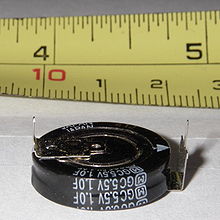- Farad
-
This article is about the unit of measurement. For the former settlement in California, see Farad, California."μF" redirects here. For the semantic markup/data formatting method, see Microformat.
The farad (symbol: F) is the SI unit of capacitance. The unit is named after the English physicist Michael Faraday.
Contents
Definition
A farad is the charge in coulombs which a capacitor will accept for the potential across it to change 1 volt. A coulomb is 1 ampere second. Example: A capacitor with capacitance of 47,000 µF (47,000 microfarads)[1] will increase by 1 volt per second with a 47 mA input current.
1 microfarad (μF) = one millionth of a farad, or 1,000,000 pF, or 1,000 nF; 1 nanofarad (nF) = one billionth of a farad, or 1,000 pF; 1 picofarad (pF) = one trillionth of a farad
Equalities
A farad has the base SI representation of: s4 × A2 × m-2 × kg-1
It can further be expressed as:

A=ampere, V=volt, C=coulomb, J=joule, m=meter, N=newton, s=second, W=watt, kg=kilogram, Ω=ohm
For electronics, one farad is a fairly large amount of capacitance. The most commonly used submultiples in electrical and electronic usage are the microfarad and picofarad.
History
The farad was coined by Josiah Latimer Clark in the year of 1861, in honor of Michael Faraday, but it was for a unit of quantity of charge.
Explanation
Values of capacitors are usually specified in ranges of farads (F), microfarads (μF or MFD, one millionth or 10-6 of a farad), nanofarads (nF, 10-9 farad), or picofarads (pF, 10-12 farad).[2]
The size of commercially available capacitors ranges from around 100 fF (femtofarads, 10-15) to 5 kF (kilofarads, 103) ultracapacitors.
When speaking of capacitor values a picofarad is sometimes referred to as a "puff" or "pic", as in "a ten puff capacitor".[3] If the Greek letter μ is not available, the notation uF is often used as a substitute for μF in electronics literature. A micro-microfarad (μμF), an obsolete unit sometimes found in older texts, is the equivalent of a picofarad. The millifarad is less used in practice, so that a capacitance of 4.7×10−3 F, for example, is sometimes written as 4,700 µF. North American usage also avoids nanofarads: a capacitance of 1×10−9 F will frequently be indicated as 1000 pF; and a capacitance of 1×10−7 F as 0.1 μF. Very small capacitance values, such as those used in integrated circuits, may also be expressed in femtofarads (fF), one femtofarad being equal to 1×10−15 F.
The 'farad' should not be confused with the faraday, which is the electric charge carried by one mole of singly charged ions.
The reciprocal of capacitance is called electrical elastance, the (non-standard, non-SI) unit of which is the daraf.[4]
A capacitor consists of two conducting surfaces, frequently referred to as plates, separated by an insulating layer usually referred to as a dielectric. The original capacitor was the Leyden jar developed in the 18th century. It is the accumulation of electric charge on the plates that results in capacitance. Modern capacitors are constructed using a range of manufacturing techniques and materials to provide the extraordinarily wide range of capacitance values used in electronics applications from femtofarads to farads, with voltage withstand capabilities ranging from a few volts to several kilovolts.
One picofarad is about the smallest value of capacitor available for general use in electronic design, since smaller capacitors would be dominated by the parasitic capacitances (stray capacitance) of other components, wiring or printed circuit boards. When capacitance values of 1 pF or lower are required, engineers sometimes create their own capacitors by twisting two short lengths of insulated wire together.[5][6]
The capacitance of the Earth's ionosphere with respect to the ground is calculated to be about 1.8 F.[citation needed]
Abfarads in medicine
An abfarad is an obsolete electromagnetic (CGS) unit of capacitance equal to 109 farads (1,000,000,000 F or 1 GF). This very large unit is used in medical terminology only.
The statfarad was the comparable obsolete electrostatic (CGS) unit of capacitance, and was equal to 1 microfarad.
See also
- Ultracapacitor
Notes
- ^ in texts prior to 1960, mf rather than the modern µF frequently represented microfarads (10-6 F). Similarly, mmf represented picofarads (10-12 F).
- ^ Newton C. Braga (2001). Robotics, Mechatronics, and Artificial Intelligence. Google Books. pp. 336 pages. http://books.google.com/books?id=yqb-f-HKem0C&pg=PA21&lpg=PA21&dq=microfarad+%22common+measurement&source=web&ots=XKiRXY4zeQ&sig=RrHw5Zbb0ymkDh9dRRul_qjsvcw&hl=en&sa=X&oi=book_result&resnum=1&ct=result. Retrieved 2008-09-17. "page 21: Common measurement units are the Farad, microFarad (uF), representing 0.000,001 F; the nanoFarad (nF), representing 0.000,000001 F; and the picoFarad (pF)"
- ^ http://scienceworld.wolfram.com/physics/Puff.html
- ^ http://www.websters-dictionary-online.com/definitions/daraf
- ^ What's All This Femtoampere Stuff, Anyhow?
- ^ Electronic Design Welcome
References
- Newton C. Braga (2001). Robotics, Mechatronics, and Artificial Intelligence. Google Books. pp. 336 pages. http://books.google.com/books?id=yqb-f-HKem0C&pg=PA21&lpg=PA21&dq=microfarad+%22common+measurement&source=web&ots=XKiRXY4zeQ&sig=RrHw5Zbb0ymkDh9dRRul_qjsvcw&hl=en&sa=X&oi=book_result&resnum=1&ct=result. Retrieved 2008-09-17.
External links
SI units Base units 
Derived units Accepted for use
with SIDalton (Atomic mass unit) · Astronomical unit · Day · Decibel · Degree of arc · Electronvolt · Hectare · Hour · Litre · Minute · Minute of arc · Neper · Second of arc · Tonne
Atomic units · Natural unitsSee also SI prefixes · Systems of measurement · Conversion of units · New SI definitions · History of the metric systemCategories:- SI derived units
- Units of electrical capacitance
- Michael Faraday
Wikimedia Foundation. 2010.


